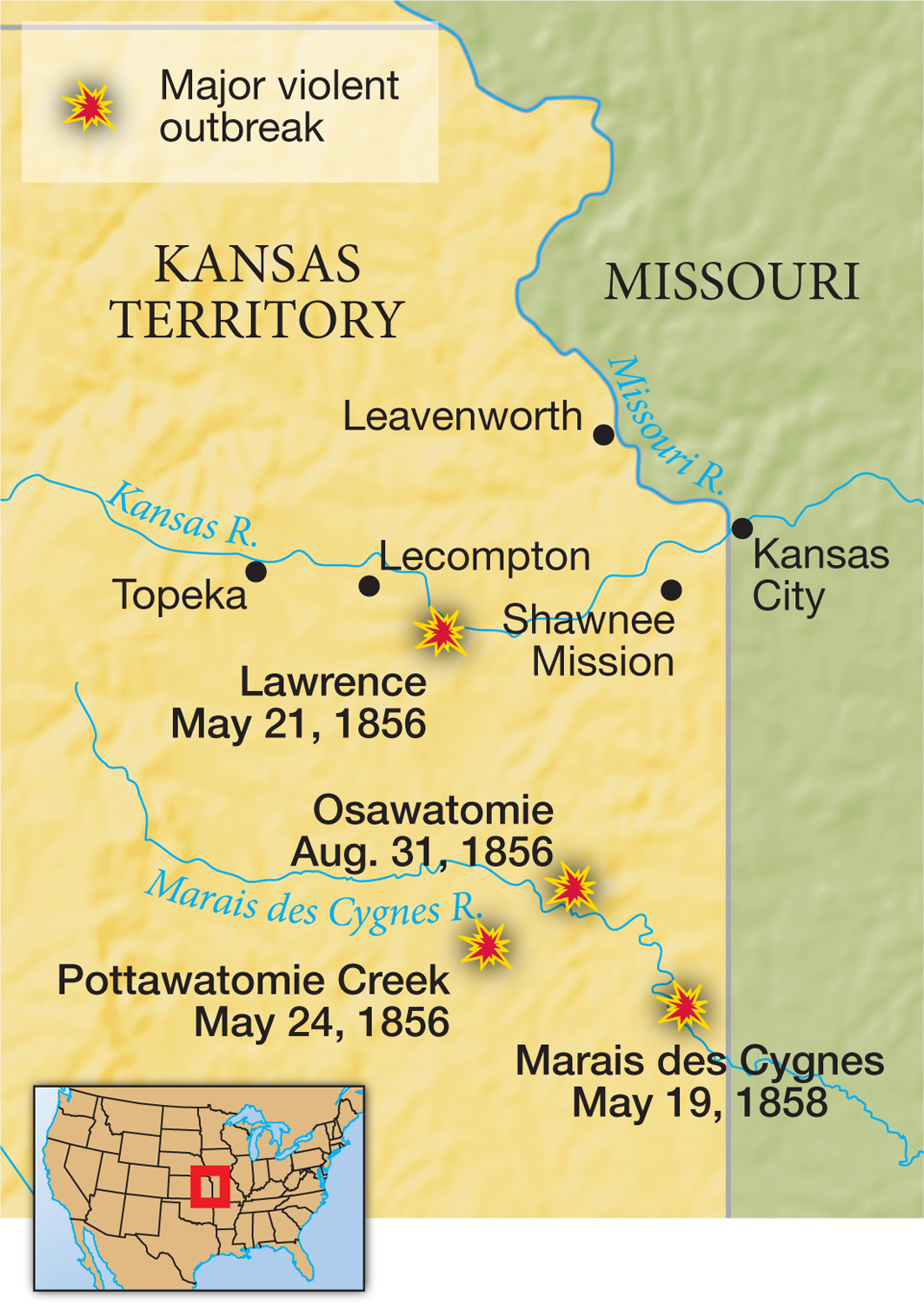The American Promise:
Printed Page 388
The American Promise Value
Edition: Printed Page 370
Chapter Chronology
“Bleeding Kansas”
Three days after the House of Representatives approved the Kansas-Nebraska Act in 1854, Senator William H. Seward of New York boldly challenged the South. “Come on then, Gentlemen of the Slave States,” he cried, “since there is no escaping your challenge, I accept it in behalf of the cause of freedom. We will engage in competition for the virgin soil of Kansas, and God give the victory to the side which is stronger in numbers as it is in right.” Because of Stephen Douglas, popular sovereignty would determine whether Kansas became slave or free. Free-state and slave-state settlers each sought a majority at the ballot box, claimed God’s blessing, and kept their rifles ready.
Emigrant aid societies sprang up to promote settlement from free states or slave states. Missourians, already bordered on the east by the free state of Illinois and on the north by the free state of Iowa, especially thought it important to secure Kansas for slavery. Thousands of rough frontiersmen, egged on by Missouri senator David Rice Atchison, invaded Kansas. “There are eleven hundred coming over from Platte County to vote,” Atchison reported, “and if that ain’t enough we can send five thousand—enough to kill every God-damned abolitionist in the Territory.” Not surprisingly, proslavery candidates swept the territorial elections in November 1854. When Kansas’s first territorial legislature met, it enacted a raft of proslavery laws, including a statute prohibiting antislavery men from holding office or serving on juries. Ever-pliant President Pierce endorsed the work of the fraudulently elected legislature. Free-soil Kansans did not. They elected their own legislature, which promptly banned both slaves and free blacks from the territory. Organized into two rival governments and armed to the teeth, Kansans verged on civil war.
Fighting broke out on the morning of May 21, 1856, when several hundred proslavery men raided the town of Lawrence, the center of free-state settlement. Only one man died, but the “Sack of Lawrence,” as free-soil forces called it, inflamed northern opinion. Elsewhere in Kansas, news of events in Lawrence provoked John Brown, a free-soil settler, to announce that “it was better that a score of bad men should die than that one man who came here to make Kansas a Free State should be driven out” and to lead the posse that massacred five allegedly proslavery settlers along Pottawatomie Creek (see the introduction to this chapter). After that, guerrilla war engulfed the territory.

Armed Settlers Near Lawrence, Kansas Armed with rifles, knives, swords, and pistols, these tough antislavery men gathered for a photograph near the free-soil town of Lawrence in 1856. Equally well-armed proslavery men attacked and briefly occupied Lawrence that same year. Kansas State Historical Society.

“Bleeding Kansas,” 1850s
Just as “Bleeding Kansas” gave the fledgling Republican Party fresh ammunition for its battle against the Slave Power, so too did an event that occurred in the national capital. In May 1856, Senator Charles Sumner of Massachusetts delivered a speech titled “The Crime against Kansas,” which included a scalding personal attack on South Carolina senator Andrew P. Butler. Sumner described Butler as a “Don Quixote” who had taken as his mistress “the harlot, slavery.”
Preston Brooks, a young South Carolina member of the House and a kinsman of Butler’s, felt compelled to defend the honor of his aged relative. On May 22, Brooks entered the Senate, where he found Sumner working at his desk. He beat Sumner over the head with his cane until Sumner lay bleeding and unconscious on the floor. Brooks resigned his seat in the House, only to be promptly reelected. In the North, the southern hero became an arch-villain. Like “Bleeding Kansas,” “Bleeding Sumner” provided the Republican Party with a potent symbol of the South’s “twisted and violent civilization.”

